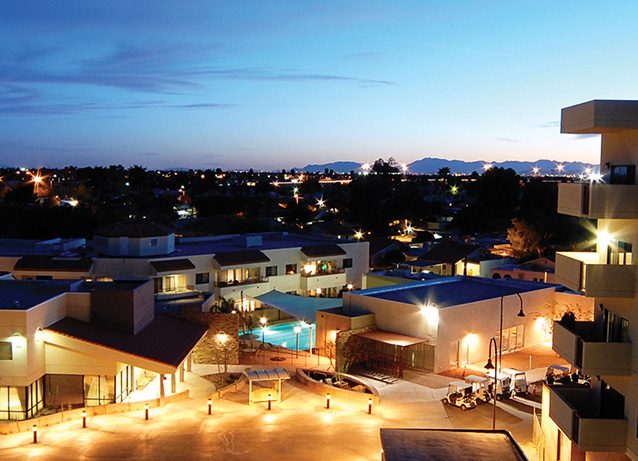
While most of us think we’ll be able to comfortably and safely age in place in our current home, the reality is quite different. According to the Department of Health and Human Services, someone turning age 65 today has almost a 70% chance of needing some type of long-term care and 20% of them will need it for over 5 years. Plus, the needed home modifications and home care costs can add up quickly. Even if you or your loved one want to stay in your home, it’s good to explore all your options including assisted living communities. Read on to compare the differences in lifestyle and cost of care.
What is Home Care?
How much home care your loved one needs depends on their mobility and overall health. For example, if they need help with the activities of daily living (ADLs) like getting dressed, bathing or housekeeping, having a home health aide stop by daily could help. However, once your family member goes beyond two or three main areas of focus, home care becomes more expensive and harder to coordinate.
What is Assisted Living?
Assisted living helps your loved one with ADLs and provides access to around-the-clock care. In addition, assisted living communities have a range of helpful services, thoughtful amenities and engaging activities. Plus, they’re built with design features to promote independence while ensuring the health and safety of your family member.
When Is It Time for Assisted Living?
There are more reasons to consider moving into assisted living than just ADLs.
- Expanded social circle: Moving to an assisted living community is a great way for your loved one to meet new people.
- Fall prevention: Assisted living communities are designed with safety features and have staff available around-the-clock in case an accident does happen.
- Access to higher levels of care: As a Life Plan Community, Friendship Village offers higher levels of care including memory care, skilled nursing and rehabilitation, if ever needed.
- Better nutrition: Weight gain or lost can be a sign of serious medical problems or a that your family member is having trouble preparing food. Friendship Village offers restaurant-style dining with well-balanced chef-inspired meals.
- Mobility issues: If your loved one is having trouble walking or getting up and down stairs, moving to an assisted living community is one way to ensure their safety.
- Difficulty with household chores: It’s easy to fall behind on maintenance and upkeep until it becomes overwhelming.
Age in Place Home Modifications
As your needs or the needs of your loved one change, it’s important that your home still fits your needs. Falls are the number one cause of serious injury among older adults, so taking steps to prevent trips and falls should be a big priority. Plus, if your mobility needs change, you’ll want to ensure your home is easy to get around. To prioritize your health and safety, here are some suggest modifications and an estimate of what it could cost to make them.
- Grab bars: Installing grab bars or railings in high-risk areas like bathrooms and bedrooms gives anyone with mobility issues additional support and prevents slip and fall injuries. Install grab bars near the toilet, and in the shower/bathtub since these surfaces get slippery.
- Bathroom changes: Bathrooms are filled with hard, unforgiving surfaces and even lifting your foot and leg a little bit could cause you to lose your balance. To further reduce your chances of falling, you should consider putting in a walk-in shower.
- Outdoor ramp: Adding a ramp isn’t just for wheelchair access. Ramps eliminate the need to navigate steps, which can make maintaining balance difficult, even with a banister.
- Add smart home technology: Items like medical alert, home security and remote monitoring or communication systems are very helpful. You may also consider adding controls for lights, entertainment systems and blinds that can be controlled with a smart phone or remote.
- Replace faucets: Touchless faucets on kitchen and bathroom sinks are great for people with arthritis or grip issues. You can also replace twist faucet handles with levers.
- Update flooring: Carpet should be securely attached and no more than a half an inch thick. Rugs are a major tripping hazard. In the bathroom you want to use non-slip tile.
- Improve lighting: Improving the lighting around your home can mean putting bright nightlights in hallways and bathrooms, using table or floor lamps for sitting areas and putting adhesive tape-lights under cabinets to provide extra countertop light.
- Replace doorknobs: Replacing the round doorknobs with lever-style handles will make them easier to open. You may also want to switch out round kitchen cabinet doorknobs with bar- or lever-style handles.
What Do Home-Modifications Cost?
- Widening doorways and hallways: This can cost anywhere from $300 to $1,000 per doorway.
- Installing ramps and grab bars: This can cost anywhere from $500 to $2,000.
- Modifying the kitchen and bathroom: This can cost anywhere from $1,000 to $5,000.
- Adding night lights and better lighting: This can cost anywhere from $100 to $500.
- Adding non-slip flooring: This can cost anywhere from $1,000 to $3,000.
- Medical alert systems: This can cost anywhere from $50 to $200 per month.
- Smart home devices: This can cost anywhere from $100 to $500.
- Walk-in shower: A basic walk-in show can cost between $1,000 and $12,000. More elaborate showers with features like built-in seats, benches, or multiple shower heads can cost upwards of $20,000.
Average Cost of Assisted Living and In-Home Care
Genworth, a national provider of long-term care insurance, conducts surveys to determine the cost of care around the country. In 2023, the average cost of assisted living in Tempe, Arizona, was $5,500/month. In comparison, the average monthly cost for a home health aide (assuming 44 hours/week) was $7,055/month.
NOTE: While the numbers above are good to get you started, you should know that the cost of care varies based on setting, geographic location and level of care required. These numbers are an average that includes all assisted living from communities that offer semi-private rooms up to those with a full apartment. It also includes small communities with limited activities up to ones with resort style amenities and on-site health care. To get a more accurate cost, contact assisted living communities and in-home care providers and tell them what you need.
A Lifestyle Designed for Peace of Mind
While gathering information can help you get a feel for what’s available, a personal visit can go a long way towards understanding the true benefits of a community’s lifestyle. To experience the difference assisted living at Friendship Village can make, contact us here.






